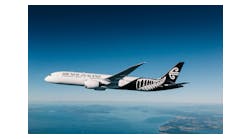Despite the sluggish economy, Canada's two biggest airlines are pushing ahead with new initiatives, from Air Canada's low-cost carrier to WestJet's regional airline.
Michael Rousseau, Air Canada's chief financial officer, told an institutional investors conference in Montreal on Wednesday that the company was just weeks away from disclosing details about its much-talked about discount airline.
"I think it's a very exciting initiative, not just for Air Canada but for all our employees because it does provide growth opportunities," Rousseau said, adding it will focus on European and sun destinations.
Even though the airline, which is targeting rivals like Sunwing and Transat, has studied different possibilities including a partnership, the new low-cost carrier will be 100 per cent owned by Air Canada with a separate management team.
That's because an arbitration decision issued in July to settle a contract with the airline's 3,000 pilots permits up to 50 airplanes - 20 Boeing 767s and 30 Airbus 319s to be used for the discount airline.
Transat, which specializes in vacation travel, reported strong third quarter results last week, suggesting it has finally turned a corner. It earned $9.4 million, or 28 cents a share, compared with a $2.8 million loss, or 7 cents a share, for the same period last year.
That has sent Transat's shares on the upswing, with analysts rating the stock as a buy. It closed at $5.55 on Wednesday, up 46 cents.
Rousseau said its discount airline will ramp up slowly next year, so it will be several years before all 50 planes will be in use.
The Boeing 767s will be used on transatlantic flights to cities not currently served by Air Canada. The other planes will be used for destinations in the U.S. and the Caribbean. Even though Air Canada may already serve some of those cities, it will aim to boost profits by moving some flights to the discount carrier.
The key will be ensuring that the airline can get more seats on each plane. Air Canada's current configuration on the 767 is 225 seats, while most discount carriers squeeze in 275 seats, a 20 per cent increase.
Changes to pay rates and work rules are also critical.
Rousseau also discounted suggestions of continued labour unrest at the airline, insisting the vast of majority of employees enjoy working for Air Canada.
"All of our employees are very professional. They are well-compensated. They are well-treated," he said, noting the day after the arbitration in the pilots' dispute, there was no increase in bookoffs.
The Air Canada Pilots Association has been mired in internal problems, with unhappy members voting out elected officials over a failed tentative agreement last year.
Jean-Marc Belanger, who was elected in March as chair of the union's master executive council, announced Wednesday he will step down on Oct. 1, more than a year ahead of schedule.
"ACPA will also have to learn from what has just transpired, adapt and reinvent itself," Belanger said in a memo to pilots. "I hope that, in spite of the current sword of Damocles hanging over our career progression and our very jobs, there will be better times for all Air Canada pilots again one day."
In addition to the discount airline plans, Air Canada is also preparing for more competition from WestJet, which has announced plans to start its own regional airline later next year.
The Calgary-based airline has made a firm order of 20 Q400 Bombardier turboprops with an option for another 25.
Speaking at the same conference, Bob Cummings, WestJet's executive vice-president in charge of sales and marketing, said that by the end of January or early February the airline will be ready to announce its regional schedule that will start with seven planes.
Copyright 2012 Toronto Star Newspapers Limited





